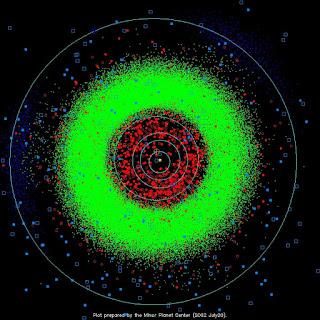All Posts (6509)
This lady has got it going on. Love her vision of fantasy and the way she writes.
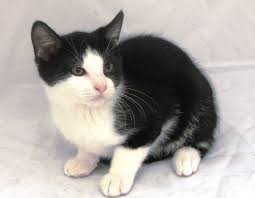 |
| The closest picture I could find that looks a lot like she looked: Mr. Johnnie Walker |
Topics: Biology, Physics, Physics and Pop Culture
We named her Felix, and probably should have named her Felicia, but she answered to that name. She was a stray my oldest son fed at our front stoop in Texas. From that point on, we had a cat.
We also had one of the best "mousers" I've ever seen. In four days she once brought four dead field mice to the front door. I used to hear it was a sign of affection, but in reality, Felix was in her own motherly way teaching me how-to mouse for myself (er, thanks). I hid them before my wife saw them all. By the fourth, she gave me a disappointed and disgusted look: "cub, you need to fix your mouse problem!" I remembered and removed the logs in the back of the house, and my rodent problem disappeared. She ruled the roost including our dog, literally terrified our Black Lab that outweighed her by 60 pounds!
Cats are often associated with a sixth sense or mystical powers, the usual go-to explanation we humans give when we don't fully understand a phenomena (see: "The Demon-Haunted World: Science as a Candle in the Dark," by Carl Sagan). This research makes a lot of sense. The article reminded me how much we all miss her. She lived to be 21-years-old, not making the trip from Texas to New York and died peacefully in the very place we found her after quietly mewing and curling up for the last time...on our front stoop. RIP, Ms. Felix.
TOKYO, June 14 (UPI) -- Experiments by researchers at Kyoto University in Japan suggest cats have rudimentary understanding of physics and the principle of cause and effect.
Previous studies have shown cats use their hearing to anticipate the presence of hidden objects. Most recently, researchers tested whether cats could anticipate an object's presence in a box based on the sound made when shaking the box. The researchers also tested whether cats expected an object to fall from a box when it was flipped upside down. The findings were published this week in the journal Animal Cognition.
Abstract
We used an expectancy violation procedure to ask whether cats could use a causal rule to infer the presence of an unseen object on hearing the noise it made inside a container and predict its appearance when the container was turned over. We presented cats with either an object dropping out of an opaque container or no object dropping out (turning-over phase) after producing either a rattling sound by shaking the container with the object inside, or no sound (shaking phase). The cats were then allowed to freely explore the experimental environment (exploration phase). The relation between the sound and the object matched with physical laws in half of the trials (congruent condition) and mismatched in the other half (incongruent condition). Inferring the presence of an unseen object from the noise was predicted to result in longer looking time in the incongruent condition. The prediction was supported by the cats’ behavior during the turning-over phase. The results suggest that cats used a causal-logical understanding of auditory stimuli to predict the appearance of invisible objects. The ecology of cats’ natural hunting style may favor the ability for inference on the basis of sounds.
United Press International: Cats use simple physics to zero in on hiding prey, Brooks Hays
In June 2006, a 16-year-old girl began a video blog on YouTube. Her name was Bree, she’d been lurking in the burgeoning community for a while. She was a self-described dork, she thought her hometown was really boring – “Maybe that’s why I spend so much time on my computer …”
She was funny, friendly, had great eyebrows. Her first few videos were relatable and cute, introducing her friend Daniel and complaining about being home-schooled and having to do homework in June. It soon became clear she was pretty lonely, which was probably why her username was Lonelygirl15.
Bree was one of a slowly-growing community on YouTube of confessional video bloggers. They poured their lives into their webcams, not yet an automatic feature on laptops as they are today. Their follower bases grew slowly but steadily, with regular, and often grainy, videos about their day-to-day lives. They were largely ignored by the mainstream media, who at the time dismissed YouTube as just a repository for cat videos.
 |
| LIGO has detected at least two black hole mergers, illustrated here. Image credit: LIGO/A. Simonet |
Topics: Astrophysics, Black Holes, Education, General Relativity, Gravitational Waves, Instrumentation, STEM
Discovery is in direct proportion to the instrumentation we currently have to detect phenomena. Thus, as our equipment gets more sophisticated, like the initial detection of Exoplanets, we'll likely encounter at least dozens more merging black holes and gravitational waves. It's why encouraging critical thinking, rationality, and science literacy - not conspiracy provocateurs, pseudo-science-word-salad-babble, Young Earth lunacy at the K-12 and secondary levels - is vital to our continued prosperity. Without it, in an increasingly technological world, we will quickly find ourselves behind...and irrelevant.
The two LIGO gravitational wave detectors in Hanford Washington and Livingston Louisiana have caught a second robust signal from two black holes in their final orbits and then their coalescence into a single black hole. This event, dubbed GW151226, was seen on December 26th at 03:38:53 (in Universal Coordinated Time, also known as Greenwich Mean Time), near the end of LIGO's first observing period ("O1"), and was immediately nicknamed "the Boxing Day event".
Like LIGO's first detection, this event was identified within minutes of the gravitational wave's passing. Subsequent careful studies of the instruments and environments around the observatories showed that the signal seen in the two detectors was truly from distant black holes – some 1.4 billion light years away, coincidentally at about the same distance as the first signal ever detected. The Boxing Day event differed from the LIGO's first gravitational wave observation in some important ways, however. [1]
* * * * *
On 3 December 2015, when the European Space Agency’s (ESA’s) LISA Pathfinder spacecraft launched from French Guiana on a Vega rocket, some big questions were facing gravitational-wave astronomers. Researchers were about to find out whether getting free-falling cubes in space to stay in sync was practical. Even if the mission succeeded, no definitive proof yet existed (although the rumor mill was in full swing) that gravitational waves could be directly detected, whether in space or on the ground.
What a difference half a year makes.
Today researchers with the Laser Interferometer Gravitational-Wave Observatory (LIGO) announced their second gravitational-wave detection, this time the result of a merger between two black holes with 14 and 8 times the mass of the Sun. These black holes are less massive but no less interesting than the already legendary black hole duo that, on 11 February, temporarily diverted the world’s attention from Donald Trump’s first presidential primary victory. [2]
1. LIGO Does It Again: A Second Robust Binary Black Hole Coalescence Observed
2. Physics Today: Looking beyond LIGO, Andrew Grant
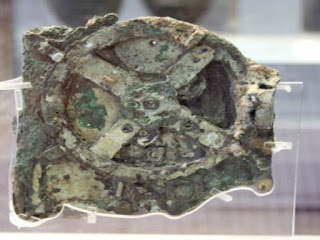 |
| Image Source: Link below |
Topics: History, Physics, Research
This sounded like an Erich von Däniken pseudo-scientific spoof, so in the vernacular of the young: I initially gave it the "side-eye." I was once an admitted early convert (hey, I was 10) and read a few of his "Chariots of the Gods" themed tomes until...science and Carl Sagan. Plus, aliens have the same physical laws - assuming similar Earth-like conditions - that we do, so it is quite plausible early engineers had the skills to fabricate such a device. It's mechanical, not Silicon after all. Eratosthenes calculated the circumference of the Earth ~2,200 years ago (see again old-school Cosmos and Carl Sagan). Though thoroughly debunked, Erich still seems to have a continuing spot on "Ancient Aliens" (YouTube is a wonder). After reading this and other posts a bit more, I was okay with putting it up and not giving ET undue credit.
The Antikythera mechanism was discovered by sponge divers in the waters off the coast of Greece in the year 1900. The device, manufactured by ancient Greeks, is composed of interlocking gears and dials. For years, scientists believed the mechanism was used to calculate the positions of planets, eclipses and other astronomical phenomena. New research suggests, however, the device may have been used as a primitive computer.
Advanced imaging techniques were utilized to decipher thousands of characters printed on the mechanism that have remained a mystery until now. After 10 years of investigation, researchers believe the mechanism was a primitive computer designed to predict the future. Investigators are comparing the ability to read these characters to obtaining the operating instructions for a mechanical device.
Roughly 14,000 characters are engraved on the device, of which approximately 3,500 are now deciphered.
"Now we have texts that you can actually read as ancient Greek, what we had before was like something on the radio with a lot of static. It's a lot of detail for us because it comes from a period from which we know very little about Greek astronomy and essentially nothing about the technology, except what we gather from here. So these very small texts are a very big thing for us," said Alexander Jones of New York University.
Tech Times: Was Antikythera Mechanism A 2,100-Year-Old Computer? James Maynard
Orbits of inner planets are shown as large circles in this computer-generated snapshot of actual known objects as of July 20, 2002. Green dots represent asteroids in the main belt between Mars and Jupiter. Red dots are asteroids that stray out of the main belt and pose a small but known possible risk of hitting Earth.
Credit: MPC, CBAT, Harvard CfA, IAU
Source: Space.com
Topics: Asteroids, Astrophysics, Geophysics, Metamaterials, Quasicrystals
Naturally formed quasicrystals—crystal-like solids with supposedly impossible symmetries—are among the rarest structures on Earth. Only two have ever been found.
A team led by Paul Asimow (MS '93, PhD '97), professor of geology and geochemistry at Caltech, may have uncovered one of the reasons for that scarcity, demonstrating in laboratory experiments that quasicrystals could arise from collisions between rocky bodies in the asteroid belt with unusual chemical compositions.
A paper on their findings was published on June 13 in the advance online edition of the Proceedings of the National Academy of Sciences.
At an atomic level, crystals are both ordered and periodic, meaning that they have a defined geometric structure, with that structure repeating itself over and over. To grow such a repeating structure without the original organization breaking down, the crystal can only exhibit one of four types of rotational symmetry: two-fold, three-fold, four-fold, or six-fold.
The number refers to how many times an object will look exactly the same within a full 360-degree rotation about an axis. For example, an object with two-fold symmetry appears the same twice, or every 180 degrees; an object with three-fold symmetry appears the same three times, or every 120 degrees; and an object with four-fold symmetry appears the same four times, or every 90 degrees.
Phys.org:
Natural quasicrystals may be the result of collisions between objects in the asteroid belt
Robert Perkins
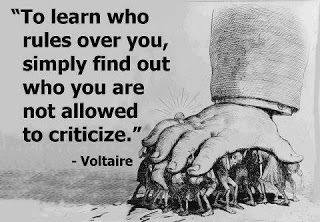 |
| Image Source: Infograph.Venngage.com, actually NOT Voltaire. Correction here |
Topics: Commentary, Diversity in Science, Politics, Women in Science
[An oft-repeated post heading] To remind what exactly authoritarianism is and why it's so destructive, I give this Eric Fromm ("Escape From Freedom") primer:
Authoritarianism: Fromm characterizes the authoritarian personality as containing a sadist element and a masochist element. The authoritarian wishes to gain control over other people in a bid to impose some kind of order on the world, they also wish to submit to the control of some superior force which may come in the guise of a person or an abstract idea.
Destructiveness: Although this bears a similarity to sadism, Fromm argues that the sadist wishes to gain control over something. A destructive personality wishes to destroy something it cannot bring under its control.
Conformity: This process is seen when people unconsciously incorporate the normative beliefs and thought processes of their society and experience them as their own. This allows them to avoid genuine free thinking, which is likely to provoke anxiety.
From the typical troupe of "God punished us for ___" response (the same after 9-11, Haiti and other perceived foibles) and the xenophobic attacks on a religion practiced by 1.6 billion people - some of them my relatives - the reactions to the Pulse nightclub shooting were myriad. Some were somber, resolved and respectful.
I never imagined a presidential candidate taking credit, the same who intelligence officials (from his OWN party) say he's fanning the flames of extremism. He somehow glossed over 50 Americans died and 53 are critically injured in now America's worst gun tragedy. Apparently for him, Twitter gloat-fodder.
"A destructive personality wishes to destroy something it cannot bring under its control."
A lot of change has happened in the last 7.5 years: the first African American president (1/44, 44: 1, 2.3% probability of "other"), the death of Osama Bin Laden; over seventy months of private sector job growth, a DOW from ~ 7,900 to 16,000; Unemployment at < 5% (literally digging out from a trough); The Affordable Care Act; The Paris Accords on Climate Change; Same-Sex marriage. A plethora of change.
Authoritarianism is the only thing that explains the canned statement I hear often: "Obama has been a disaster." Any other president with just his domestic accomplishments would be proposed for inclusion on Mount Rushmore. It occurs to me (my internal mental rejoinder) that the real "disaster" is narrative. African Americans must make a mess of things; BE a disaster despite facts to the opposite. "Change" is anathema to authoritarian personalities. Technology - yes; society - no. Roles defined for gender, race and sex must be adhered to and obeyed, transmitted from on high by a strongman or an ideal. Or, I can only assume someone's sensitive feelings will be hurt.
"A destructive personality wishes to destroy something it cannot bring under its control."
There was quite a firestorm about the remake of Roots, most notably from the bravura thespian Cordozar Calvin Broadus, Jr. AKA "Snoop Dog" whose cinema accomplishments heretofore haven't been exactly "uplifting" to the culture. True: we should not JUST tell slave stories, but false: we shouldn't forget them either. We were reluctant immigrants, the result of a kidnapping on the Orwellian-named "Good Ship Jesus." Our story is intricate in this country's "exceptionalism," our free labor making the US a global economic power. Cotton to oil; slavery to outsourced labor not much has changed other than technology. I look forward to seeing if he's on the credits as producer of the coming NASA biopic "Hidden Figures," an uplifting tale about African American women mathematicians in the 1960's. (Here's your chance, Broadus.)
The Jewish community often say "never forget" regarding their holocaust, and neither should we ours. Africans were the first to stage uprisings to authoritarianism (slavery...whips...chains...children-sold-off) examples to use a recent term from the House Speaker: "textbook" authoritarianism. Beyond those whips and chains, we've contributed to the growth and prosperity of this nation and world, as have all other groups of our citizenry.
The violence that we see has always been America. Disparate groups from African Americans, Asian Americans, Hispanic/Latino Americans, Italian Americans, Irish Americans, Jewish Americans, LGBTQ Americans, Native Americans; Women: all who have reached for equal rights (and in the case of women most recently, equal PAY) have always endured a violent backlash, be it political or actual. There's a need for the authoritarian to "go backwards" to a halcyon, Utopian time that upon clear examination of historical facts never existed for the aforementioned disparate groups.
But they really aren't that different. All were and are Americans by the 14th Amendment. All had and have rights to life, liberty and the pursuit of happiness in The Constitution.
The shooter - of Afghan descent, but born in New York - was described by his EX-wife as violent and emotionally disturbed. His father - in an attempt to place his son's crime in context - stated he was offended by a "gay couple kissing"; it was not due to his religion. This explanation as "context" is tepid at best. Emmett Till's apparent sin was whistling...
"A destructive personality wishes to destroy something it cannot bring under its control."
So, it is not a matter of going backwards or minority groups, LGBTQ and Women just "keeping quiet" and everything will simmer down. That is the textbook description of a hostage scenario, not citizenship.
"A destructive personality wishes to destroy something it cannot bring under its control."
Rhetoric - either written or spoken - always proceeds violence. We will soon have a choice of the country we aspire to be...or perhaps unmasking [for] ourselves for all time, revealing beyond the illusion of what we think of ourselves, to what we've always been.
Getting your Dream to the Screen: http://ovation.sheridancollege.ca/film/
Sponsorship for Online Video: https://www.videomaker.com/article/c7/15698-sponsorship-for-online-video
Saturday morning, decided to do the laundry and dishes. Set up my tablet to listen to a video short on jazz. It was about Sun Ra, John Coltrane and Anthony Braxton and the times of their music. Then I listened to Kevin Spears (electronic Kilimba), Emmett Chapman (inventor of Chapman Stick), Kevin Keith (Chapmen Stick artist), Pharoah Sanders, Sonny Rollins and Eddie Harris (Jazz saxophonists). Sun Ra's theme was playing in the back of my mind, "Space is the Place, yeah yeah Space is the Place.
Funny how we are so programmed to think Sun Ra was talking about outer space. Why would anybody think dwelling in an environment that is meant to kill you with every force, element and substance? Sun Ra was talking about freeing your mind. Your imagination is the space. The scene in the movie Matrix where Neo says, "this is the construct", then he asked the computer to bring weapons and for as far as the eye can see there were guns of all sorts, even though you could only shoot one or two at a time. This showed our limitations against the limitless imagination.
We live in a chaos world of distractions, yet when one of us gets focused amazing things happen. A Nigerian kid's favorite places are a junkyard and a library. With only the basic education and concepts he turns scrap parts into a windmill to power a pump for his family home, then the village. I saw him in a TED video. Here in the USA we are inundated with so many isms, schools of thought, commercials, media, social guides and misguides and Pavlov response psychology.
Sun Ra said Space is the Place, harnessing our mind power of imagination is something we all know but down play as not important. All the philosophers say how a man thinks so he is. We turn around and say that person is full of himself (ego overload) or in a cult (culture) if he espouses an social ideology be it religious, political or social. Heck we have gods who are outside of us and or inside of us and are other than us. We are separated from god by galaxies and yet are immersed in god like a fish in water. All the knowledge we have about things are true and are also a lie, we work stuff up in our mind standing on a tiny mountain. It's really an iceberg the mass hidden under distracting waves.
The place of space is not the limited physical worlds but worlds within. The ancients talked of meditation, the waking dream, the space between being fully awake and fully asleep. Sleeping on it consist of going to bed with something on your mind perchance your unconscious mind will spit out a solution, an inspiration in the morning into your awakened state.
Speaking of states many of the states (mindsets, dress, physical display) are prescribed by us some are assigned to us. Being a Negro, Black, African-American, a kid from the Bronx, from Philly, from Cleveland, we say pop, you say soda. Each state has it's baggage, it's expectations, it's consequences. I've met shapeshifters who change states to accommodate the people they are with (beware of shapeshifters). They can appear in one state while totally espousing another. On the campus you become aware of all the states we can assume. Some shift, some are consumed, some guileless, true blue, the genuine article (god I love those people!).
We did Black Power, African heritage and now are exploring our "indigenousness". A concerted effort is afoot to disengage us from every culture, history and heritage on the planet. They are driving us into Space. If we are crazy we will end up reaching up into the sky trying to get there. Space is the place but which space. There is a space I hear and see every time I put on some jazz. The instrument meant to go "oomp pa pa" goes "be boop da da pop boomp de bap da da". The family so distracted by being neighborhood immersed produces a kid focused enough to sail through school at the top, first in family to college, gets PhD and or starts a business. How do some break the mind chain to excel yet ridiculed by the rest of us because they are in a different state of mind than us, duh!? Eh Bro, you too good for us now? No, man, I'm just with different people now cause I am a different person now, a different state (Space) now.
How to get the programmed media out of your space is an on going topic. How to get the our people generated negative talk out of your space. How to get the self generated crap out of your space. How to recognize yourself while handling yourself in your own space. How to dwell comfortably in our own space and your own skin. How to make room for yourself to create what you will in your own space.
Space is the Place, that space and that place IS in your head, is your imagination and you own it. What you imagine (I believe in degrees) you become or can create, make, produce and market. We have no need to hear what others think of us or describe us (our on going concern). We are a pretty advanced people spanning from poor and stupid to multi-faceted and multi-talented geniuses depending on how our minds are loaded and our minds are focused. The next step is to recast what opportunity is. Opportunity has been based on the needs of other peoples. We need to look at our own needs again, our own mediums of exchange, conversion of that medium for external exchanges. I'm sliding off topic but the state we are in comes with it's own considerations. We have to be willing change our states to positive collaboration no matter the appearance.
Anyway, Sun Ra was talking about mental space, imagination, states of being. Imagination is powerful, not just a playground for musing thoughts and terrifying fears. Imagination is our mind Space, the Place in the Space of our mind. We fight to get a bunch of us to embrace one ideology or another to take over the world, religious, political, social, history. We think if we do the world would be at peace because we all think the same thing. The answers I don't know but the field of battle has always been the minds of men. Sun Ra said Space is the Place you can create a world that suits you, benefits you and in it you can be.
OSA sponsors multiple programs to promote optics and photonics among K-12 students.
Legacy programs include the Optics Discovery Kit and the Optics Suitcase. Online, OSA sponsors the Optics4Kids site which provides information and educational resources. (iStock.com$#92;VYCHEGZHANINA)
(Courtesy of iStock.com\VYCHEGZHANINA)*
Topics: Diversity in Science, Einstein, Electromagnetism, James Clerk Maxwell, Laser, Modern Physics, Optics, Quantum Mechanics, Women in Science
"It is better to light a candle than curse the darkness." Eleanor Roosevelt
In June 1916, exactly one century ago, Albert Einstein predicted the existence of ripples, known as gravitational waves, in the fabric of spacetime. Earlier this year we celebrated the stunning observation of the phenomenon by a worldwide collaboration of more than 1000 scientists using incredibly sensitive antennas built of mirrors and lasers. (See Physics Today, April 2016, page 14.) As with many scientific achievements, this recent milestone draws on innumerable theoretical, observational, and technological innovations and iterations made along the way. It’s worth reflecting on the vast body of knowledge the scientific community has generated, the breakthrough technologies that have allowed us to observe our world with ever-greater depth and precision, and the people who have dedicated their lives and careers to expanding knowledge and applications in diverse branches of science.
This year marks the 100th anniversary of The Optical Society, a worldwide community for optics and photonics professionals and students. Over the past century, the research world and consumers alike enjoyed a dramatic expansion of light-based science and applied technology. In many ways, the growth of optics and photonics has mirrored the birth and expansion of modern physics from the early 20th century through today. Applied optics and spectroscopy have long played a central role in enabling new discoveries in physics; that new physics has fueled advances in optics and photonics that, in turn, have created powerful tools for the study of space, time, and matter. The laser, for instance, has become an indispensable tool of scientific inquiry. Solid-state detectors of incredible density and sensitivity are used for scientific imaging from telescopes on Earth to cameras on Mars. Innovations in laser cooling have given us unprecedented access to the quantum world, and laser frequency comb technology has greatly expanded precision measurements for both fundamental and applied sciences.
But that list is far from complete. This article permits only a sparse survey of the noteworthy advances and trailblazers from the past century of optics and of the innumerable benefits we derive from them. Further highlights are available on the OSA Centennial webpage at www.osa.org/en-us/100/osa100*.
Physics Today: A century of light, Anne Frances Johnson and Nancy D. Lamontagne
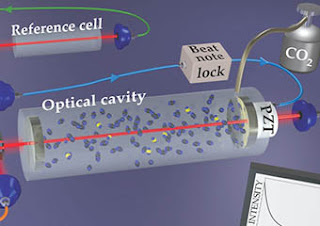 |
| Physics Today: Optical detection of radiocarbon dioxide (partial view) |
Topics: Modern Physics, Radiation, Spectrograph
A compact spectroscopic system can measure radioactive carbon dioxide concentrations as low as five parts per quadrillion.
Carbon’s only naturally occurring radioactive isotope, 14C, is exceedingly rare. Produced when neutrons from cosmic rays interact with nitrogen, the radioisotope makes up just one part per trillion of the carbon in Earth’s atmosphere. Yet because of its continual production, its diffusion through the planet’s carbon cycle, and its long half-life of 5700 years, 14C is routinely used to date organic matter as old as 50 000 years. Archaeologists, forensic scientists, and environmental researchers, among others, essentially measure the concentration of radiocarbon in a sample to determine its age.
Since the late 1970s, accelerator mass spectrometry (AMS) has served as the benchmark method for the job. In that approach, samples are burned, chemically converted to graphite, and bombarded with cesium ions. The negative carbon ions ejected from the solid samples are then accelerated to a few percent of the speed of light and their mass-to-charge ratios deduced from their trajectories through electric and magnetic fields. Fortuitously, the most common isotope of nitrogen in the atmosphere, 14N, forms no stable negative ion; and its absence eliminates its otherwise large interference with the 14C signal. Likewise, 12CH2 and 13CH molecules are broken apart during a later, electron-stripping stage and don’t survive to interfere with the signal.
Both effects help free 14C signals from background noise. But although the technique is powerful—and applicable to other trace elements—the spectrometers can cost millions of dollars and often require a dedicated facility to maintain their electrodes at hundreds of thousands to millions of volts in a vacuum.
A technically simpler approach also begins with burning a sample, but only to transform its carbon atoms into carbon dioxide molecules. With their strong vibrational absorptions in the mid-IR, the many isotopic combinations of CO2 can be distinguished optically. The challenge is to measure the intensities of their spectral lines to determine the concentration ratios. The task is not easy if the goal is to count trace isotopes in a sea of abundant ones. The CO2 molecule has hundreds of vibrational and rotational lines, many of them closely spaced in frequency. And even the most stable lasers suffer from intensity fluctuations.
Physics Today: Smaller, faster, cheaper detection of radiocarbon, R Mark Wilson
 |
| A new type of particle could have interacted with protons and neutrons shortly after the Big Bang, so as to break up lithium-7. (Courtesy: iStockphoto/Insomnela) |
Topics: Astrophysics, Big Bang, Early universe, Particle Physics, Theoretical Physics
I remember Racer X as a child, but this is just another reason to blame for our laptop batteries not holding a charge as long as we'd like.
For a little more than a decade, scientists have been struggling to explain why the amount of lithium predicted to have been formed in the early universe is about three times the value actually observed. Now, an international team of researchers believes it may have the answer: a new type of particle, outside of the Standard Model, that would have interacted with protons and neutrons shortly after the Big Bang so as to break up lithium-7.
According to a theory known as "Big Bang nucleosynthesis", protons and neutrons fused to form nuclei in the first few minutes after the Big Bang. This process generated deuterium, large amounts of helium-4 and smaller amounts of helium-3 – the latter two combined to create beryllium-7, which eventually decayed to lithium-7. The theory makes very precise predictions of the relative proportions of these nuclei, based on a quantity – known as the photon–baryon ratio – taken from observations of the cosmic microwave background.
For helium and deuterium, these predictions agree very well with observations of physical systems thought to contain material dating back to the time of the Big Bang. However, the theoretical value for lithium – just five per billion of hydrogen – is between two and five times too high.
Now, Maxim Pospelov of the Perimeter Institute in Waterloo, Canada, together with colleagues at the Austrian Academy of Sciences in Vienna, says that this mismatch is not a "full-blown crisis for cosmology" because the observed lithium-7 levels, which are obtained from atmospheric spectra of very old stars, might not match primordial values. The researchers say that obscure astrophysical processes might have depleted lithium within the stellar atmospheres, but add that astrophysicists have yet to pinpoint such a process.
Physics World: Particle 'X' may have snuffed out cosmic lithium, Edwin Cartlidge
I have heard so many versions of history from many folks. When I was exploring my ancestry by means of family reports I seemed to illuminate the complete scene from the snippet.
A twice great grand parent was Irish, changed his name. Was he a criminal, a runaway slave ((indentured servant) white slavery a very hidden American history). He married a Cherokee, full or half, might have been a Freeman or a Black Indian (there is such a thing, implies so much). Their son married a lady, they don't know her last name or origin, anyway my grandmother, her sisters and brothers have so-called "traditional Indian looks" (nose, cheeks, hair). They never mentioned Indian origins while I was growing up. My dad had some looks but I never associated with Indian features. His older brother, my Uncle Ike, looked Indian and his younger brother had "good" hair and was extra handsome.
Another great uncle said he was from "Molyglasco island off the coast of Africa", he had mahogany skin, good hair and a singing voice. East Africa has Madagascar, Borneo, piracy and slavery in the past, said he was sold into slavery when he got here. Here he joined the Northern Army, escaped into Canada, married, came back through Ypsilanti Michigan.
Now both my mom's grand folks come from Alabama, one classed negro the other a mulatto. Of course mulatto meant a mix of Indian/Negro but could have been Indian/white more than white/Negro. Alabama was land to Muskogee, Creeks, maybe a few others and I don't know many Africans were enslaved in that area, let alone native free blacks. More stories about displacement, being moved than being entrenched in labor camps.
Anyway my point is that when I touch the small family reports big scenes open in my mind as if I can see a whole story. I am sure many of us have the same experiences. When I do my futurist art I envision this past coming forward. Some of us are compelled to tell the stories even though we don't know the facts. It all comes from a deep dreamy place.
 |
| Image Source: Physics Today |
Topics: Astrophysics, Black Holes, Cosmology, Dark Matter, General Relativity
Shooting out of the galaxy at speeds greater than the escape velocity, hypervelocity stars provide a window on black holes and the distribution of dark matter surrounding the glowing Milky Way.
Because gravity keeps stars on their orbits, astronomers can use the motions of stars to infer the mass distribution of the visible and invisible constituents of the Milky Way. The Milky Way is the only galaxy whose visible mass distribution we can see in three dimensions and in which we can accurately measure the velocities of millions of individual stars. Gravitational accelerations in the galaxy are usually small, however. Our sun, for instance, experiences a gravitational acceleration of just 2 Å/s2 as it orbits the Milky Way. That’s 10−11 of what we experience on Earth’s surface. It’s also the gravitational- acceleration regime of dark matter—the unseen material inferred to exist in and around galaxies.
Some of the initial evidence for dark matter came in 1932 after Dutch astronomer Jan Oort developed the first modern theory of stellar motions.1 Oort compared the velocity dispersion of stars near the Sun with their number density and inferred the existence of more mass than could be accounted for by the visible stars. In more recent times, radio astronomers have measured the rotation speeds of gas—specifically neutral hydrogen—in the outer parts of the Milky Way and other disk galaxies with much higher accuracy than could be done in Oort’s era. Intriguingly, they found that rotation speeds do not decline with increasing distance outward but stay constant. To keep galaxies like the Milky Way bound together requires the gravitational pull of dark matter, if not a modified theory of gravity.
The focus of this article is a new class of astronomical objects, known as hypervelocity stars, that uniquely connect the center of the galaxy to its outer halo. A decade ago I and my colleagues Margaret Geller, Scott Kenyon, and Michael Kurtz at the Smithsonian Astrophysical Observatory in Cambridge, Massachusetts, unexpectedly discovered a star moving away from Earth at 850 km/s, roughly 2 million miles per hour.3 The speed is astonishing: The star is racing outward with at least twice the galactic escape velocity at its distance of 300 000 light-years from the galactic center.
Physics Today: Hypervelocity stars in the Milky Way, Warren R Brown
still working on chapter 4. nearly finished.
in the mean time, here's a poster.
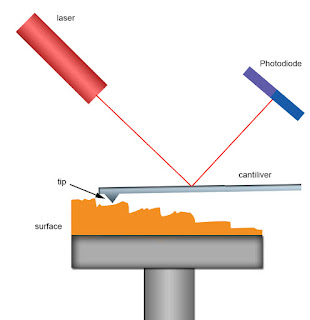 |
| Source: Artificial Oxide Nanostructures: Physics of Multiscale Phenomena |
Topics: Atomic Force Microscopy, Biology, Cancer, Consumer Electronics, Electrical Engineering, Nanotechnology, Semiconductor Technology
Thirty years since its first inception, the atomic force microscope has proved a hugely versatile tool. Applications range from quantifying dopant distributions in electronics and the analysis of dust particles in space, to characterizing biopsies for cancer diagnostics. More than simply bringing atomic-scale resolution to non-conducting surfaces, modifications of the technology have provided important tools for sensing chemical entities and mechanical properties, with force sensitivities so great they can be used to study and control mitosis in the proliferation of life itself. nanotechweb.org visited Basel in Switzerland, home to some of the pioneers in AFM technologies, to find out how far the field has come in the past three decades.
The development of scanning probe technologies began with the scanning tunnelling microscope (STM), and was driven by the semiconductor industry in the late 1970s. Christoph Gerber, co-inventor of the atomic force microscope, points out that although electronics feature sizes were coming close to the nanometre scale in the 1970s, there was no way of obtaining spectroscopic information of such small features. “We thought that if we established a tip very close – so that due to the proximity there would be tunnelling - we would have an instrument that could do this kind of spectroscopic work.” From there came the idea of scanning the tip and keeping the quantum tunnelling current constant. This would effectively trace a topography of the surface with a lateral resolution that could image atoms. “The big breakthrough for STM came when we were able to image the 7 × 7 reconstruction of silicon (1,1,1),” explains Gerber. As the arrangement of atoms at the surface differs from the bulk, glimpsing this reconstruction in a real image was a powerful demonstration of the instrument’s potential.
Francois Huber, who shares a lab with Hans Peter Lang, highlights how the cantilever arrays have also become useful for identifying single gene mutations from biopsies. Recently introduced cancer drugs have particularly high efficacy for specific cancer genes, such as the HER2 gene for aggressive breast cancer and the BRAF mutation found in 50% of malignant melanoma incidents. “Before we treated cancers with general chemistry or radiation – everybody got the same treatment and either you were lucky or unlucky,” says Huber. “Here we can actually target the cancer directly – it goes towards personalized medicine so that you treat patients according to their genetic predisposition.”
Nanotechweb: Atomic force microscopy – 30 years on
FBI Agent Audra Wheeler has been haunted for the last thirteen years by a paranormal attack that left her sister, Kendra, in a coma. Mentored by FBI Assistant Director Jonathan Cordero to investigate crimes committed by specters, Audra believes she is on the trail of a ‘serial killer’ specter with a MO very similar to her sister’s attacker. The investigation takes her to a small town of Specter, Georgia; a haven for ghosts who exist among the living.
https://www.amazon.com/dp/B01GILL3OG/ref=cm_sw_r_tw_dp_T8dvxbJE2T3WT
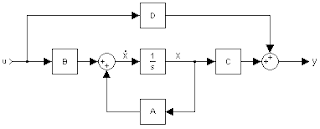 |
| State-Space Equation of a Feedback Loop, Source: Wikibooks |
Topics: Commentary, Education, Politics
Spoiler alert: This post has nothing to do with Control Systems Theory.
I recall reading a story in the Winston-Salem Sentinel (when we had morning and evening newspapers): about a young man, my age at the time (11-years-old). His parents motivated him by paying $10 for every “A” he made. One semester, he made a “B.” To teach him a lesson – the article reported – his parents paid him nothing on any of the other A grades. He promptly – or, sometime during that day – went out to their barn and tragically used his family's shotgun. I would get older...he would not.
When I first attended NC A&T State University, like most freshmen, I was in love with someone who wasn’t on campus (she was a high school senior). Looking back, our difference in age and maturity should have made me immediately end the relationship on my getting to campus. I initially majored in Engineering Mathematics, knowing I wanted to be in a STEM field, but not quite committing to Electrical, Mechanical or Industrial Engineering (as I look back, I’m not quite sure why).
My first semester ended with average grades, but my relationship back in Winston-Salem got harder to manage. I thought more frequent visits would heal our divide that kept getting wider. To make a long story short: I achieved four “Fs” for my trouble, and got placed on academic probation. My father – after our breakup – gave me a stark choice: get it together, or go in the military. (I did eventually on graduation, but as an officer in the Air Force.)
I met Dr. Tom Sandin purely by chance in front of Marteena Hall as I pondered my father’s ultimatum. Dr. Sandin was funny and affable, and suggested I not quit, but instead “try physics.” Physics, I thought? What evidence do I have now that I’m even good enough to complete a degree, let alone increase the complexity of my matriculation? Tom Sandin insisted, and I changed my major from Engineering Mathematics to Engineering Physics. It was encouragement, but that was enough. That's not to say Tom Sandin was an easy teacher! I got many a low grade with the note "see the answer" that he posted after every homework or quiz in the Library Mezzanine. I worked hard, sacrificing Fridays, weekends and summers my peers used to work internships for summer school courses; every summer until I graduated. I gradually pushed my GPA to a 3.0 (the four Fs prior dragging down my overall). I made the dean’s list a few times. I found out later to my delight, that Dr. Sandin also taught a personal hero of mine, Dr. Ron McNair, the first black astronaut from a HBCU; I met him in Greensboro when my Air Force ROTC detachment honored his maiden voyage into space. I was emotionally saddened by the Challenger Disaster.
Failure is feedback. Sometimes the thought of failure - earned or unfair - in life can be a great motivator and filter of what you will and will not do.
I called Ron McNair before his final mission, December of 1985. He revealed to me that someone at MIT sabotaged his research five weeks before his PhD dissertation, considering the times, likely due to jealousy and racism. He didn't let that stop him. He re-accomplished five years of research in three weeks time. He did not sleep until he had completed his oral defense. After that, Dr. McNair (officially) slept for a week.
I can’t help but thinking what happened at UCLA is a reflection on the society we’ve created. Millennials are joked about, parodied, etc. I recall, and know most martial arts organization, soccer, T-ball and extracurricular activities give participation medals (see the parody). Charlie Brown would strive every summer to win a baseball game; he would strive mightily to kick the football before Lucy pulled it away: he never did it. We understood it was Charles Schultz's camp humor that made the gag work every time, but it was an object lesson: it showed perseverance, that you don't have to start out "perfect" and always be perfect to be successful. Unlike Charlie Brown, we can learn and grow from our mistakes.
What happened at UCLA could be any campus USA. It’s similar to what happened in Aurora, Colorado when James Holmes killed twelve people and wounded several others: he’d failed his qualifier in graduate school for Neurosciences. Holmes - as someone who’d likely never received a failing grade in his life, freaked. He never fell in love and failed four subjects; no one sabotaged his research due to his cultural ancestry. I’m sure this man who killed his engineering professor in California (and apparently had a "kill list" of additional offenders) had a similar, privileged pedigree. Unlike Holmes, he apparently achieved a PhD. Also unlike Holmes: because of his name, cultural background, ethnicity and the volatile election cycle, he didn't do us any favors in a clearly fractured nation, split by crassly manipulated bigotry for political gain.
Life will be challenging and disappointing, academically, personally and professionally. What distinguishes achievers from others is being willing to learn from mistakes and grow better from them. Violent tantrums – especially the lethal kind – serve no purpose, other than brief sensationalism... and oblivion. A personal Armageddon is not a reward, nor a victory. It is as this essay began and always will be: tragic.
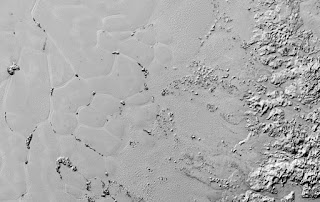 |
| Sputnik Planum on the surface of Pluto, as seen by the New Horizons spacecraft. Several polygons are visible in the image. (Courtesy: NASA/JHUAPL/SwRI) |
Topics: NASA, Planetary Science, Pluto, Space Exploration
The patchwork of polygons on the surface of a vast plain of ice on Pluto is created by heat upwelling from the interior of the dwarf planet. That is the conclusion of two independent teams of scientists that have combined data from NASA's New Horizons mission with computer simulations to gain a better understanding of Sputnik Planum – the flat region where the mysterious polygons exist. One important consequence of the convection process is that the surface of Sputnik Planum could be less than one million years old, making it one of the newest known surfaces in the solar system.
NASA's New Horizons spacecraft reached Pluto in July 2015, making it the first mission to explore the dwarf planet. The spacecraft has since provided scientists with a wealth of information about Pluto and its moons as well as the first images of Pluto's icy surface, which captured the imagination of scientists and the public alike.
Sputnik Planum, which is an ice-filled basin that occupies an area of about 900,000 km2, makes for a particularly interesting feature. The surface of the ice – which is believed to be mainly nitrogen – appears to be broken up into a collection of polygon-shaped tiles, each of which measure anywhere from 10–40 km across. The polygons are not flat – rather their centres rise up tens of metres above their edges to create a gently rolling icescape.
Physics World:
New Horizons lifts the lid on Pluto's peculiar polygons, Hamish Johnston
